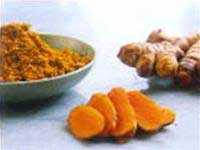Tumeric: A Medicinal Herb
Tumeric is a perennial herb with a thick, knotted rhizome that branches into multiple tubers, ranging in color from dark yellow to reddish-yellow, and has a strong fragrance. The leaves grow directly from the rhizome, with a narrowed base and a slightly pointed tip. Both surfaces of the leaves are smooth and light green, with undulating edges. The leaf sheath is broad and long.
The flower clusters are cylindrical or egg-shaped, attached to a thick, long stalk that emerges from the middle of the leaf cluster. The bracts are separate and very light in color. The lower bracts bear reproductive flowers, which are green or light white, while the upper bracts do not bear flowers, are narrower, and have a pink hue at the tips. The calyx has three uneven lobes, the corolla has a long tube, and the middle petals are longer than the side petals, with a yellow color. The fruit is a capsule with three compartments, containing seeds with a coating.
 Pharmacological Effects
Pharmacological Effects
Tumeric has anti-inflammatory properties in both acute and chronic models, such as foot edema and granuloma formation in white rats. It also causes atrophy of the thymus in young male rats, which are typical anti-inflammatory drug effects. Tumeric essential oil exhibits anti-inflammatory activity in experimental arthritis. Curcumin and its derivatives are the active compounds in tumeric. The anti-inflammatory mechanism may involve the elimination of free radicals that play a crucial role in the inflammatory process.
Tumeric also has anti-ulcer activity and aids in digestive disorders. An extract of tumeric given to rabbits reduces gastric secretion, increases mucus secretion in gastric juice, protects the gastric and duodenal mucosa, and prevents ulceration caused by pyloric constriction, stress from restraint, fasting, and side effects from certain medications. Tumeric stimulates mucus production in the stomach lining. Curcumin inhibits gas production in the intestines.
Tumeric essential oil increases bile secretion and stimulates gallbladder contraction in experiments on dogs. An extract of tumeric has protective effects against liver damage in experimental animals.
The essential oil and some chemical constituents of tumeric inhibit various pathogenic bacteria and fungi, including Mycobacterium tuberculosis, Shigella, Streptococcus pneumoniae, Salmonella, Escherichia coli, and Candida albicans. The tumeric extract has been shown to inhibit amoebic dysentery. An extract from tumeric leaves kills mosquito larvae.
Clinical Pharmacology
Patients were given 500g of tumeric powder four times a day for seven days, resulting in significant improvement in symptoms of acid dyspepsia, bloating, and atonic dyspepsia. A clinical study on rheumatoid arthritis patients showed that curcumin improved morning stiffness, joint swelling, and walking time.
The combination of tumeric and Atractylodes has been used clinically to treat gastric and duodenal ulcers, providing quick relief from pain, reducing gastric acidity, and resolving digestive disorder symptoms, although no significant changes in X-ray images of the ulcers were observed. Tumeric pills, made from yellow tumeric, licorice, and belladonna, have been effective in treating gastric ulcers, alleviating epigastric pain, sour belching, and nighttime pain.
Plasters for boils made from tumeric and other medicinal herbs were applied to 30 patients with boils, achieving an 84% recovery and improvement rate. The treatment was simple, with no need for incisions, injections, antibiotics, or dressings.
Uses of Tumeric
Tumeric is used to treat cases of bruising, gastric ulcers, tumors, scabies, rheumatism, joint pain, and jaundice. It is also used to treat menstrual disorders, uterine blood stasis, and retained lochia after childbirth, which can cause abdominal pain. The recommended dosage is 2-6g per day, divided into 2-3 doses, in the form of powder or decoction.
For external use, fresh tumeric can be crushed to extract juice for application on boils, ulcers, and newly healed wounds to reduce scarring. Tumeric is also used in some other countries for treating cough and pulmonary tuberculosis.
Tumeric Remedies
For treating gastric and duodenal ulcers, stomach pain, bloating, and sour belching:
Use 10g of tumeric, 12g of dried tangerine peel, 12g of bitter herb, 10g of nutmeg, 10g of dandelion, and 8g of wormwood. Prepare as powder. The daily dosage is 10-20g, divided into 2 doses.
Combine 12g of tumeric, 20g of roasted black beans, 12g of ginseng, 12g of Chinese yam, 10g of hoelen, 10g of dried tangerine peel, and 10g of honey into pills. The daily dosage is 10-20g.
For treating acute viral hepatitis:
Combine 12g of tumeric, 40g each of plantain and dandelion, 40g of reed root, 16g of gardenia, 12g of roasted rhubarb, and 8g of coptis. Prepare as a decoction to drink once daily.
For treating hepatitis, liver insufficiency, and jaundice:
Use 5g of tumeric, 10g of bael fruit, 5g of gardenia, and 5g of corn silk. Prepare as a decoction to drink once daily, or make into syrup or powder.
Combine 2g of tumeric, 4g of gotu kola, 3g of nux vomica, 3g of plantain or bael fruit, and 2g each of South American burdock, gardenia, and Chinese yam.
Grind tumeric, gardenia, and burdock into a fine powder; the other ingredients are made into a concentrated decoction. The daily dosage is 10g.
For treating hemoptysis and nosebleeds:
Finely grind tumeric; the daily dosage is 4-6g, taken with water.
For treating gallstones and dissolving stones:
Use 40g of creeping jenny, 12g each of tumeric, vân mộc hương, plantain, and rhubarb. Prepare as a decoction, taken once daily.
To prevent and treat uterine blood stasis after childbirth:
Eat 1 tumeric rhizome, roasted and chewed, or crush it and cook with sticky rice.
For relieving menstrual pain:
Combine 12g of tumeric, 20g of motherwort, 16g of rehmannia root, 16g of black snake root, 12g of Chinese angelica, and 8g each of peach kernel, nutmeg, and dried tangerine peel. Prepare as a decoction to drink throughout the day.
Combine 8g of tumeric, 16g of motherwort, and 8g each of peach kernel, ligusticum, and achyranthes. Prepare as a decoction to drink throughout the day.
Plaster for boils:
Combine 60g of tumeric, 80g of Chinese yam, 80g of sesame oil, 40g of rosin, and 40g of beeswax. Clean the yam, then crush it along with the tumeric until very fine. Cook this mixture with the rosin, sesame oil, and beeswax until well combined. Strain, allow to cool, and apply to paper, then stick onto the boil.

















































